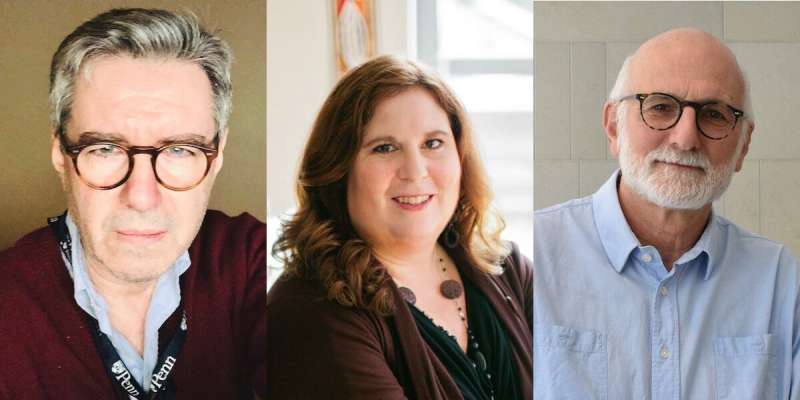
COVID-19 has put race-based health disparities on full display, but such inequities extend far deeper than the current pandemic. An enduring challenge for physicians and scientific researchers has been to distinguish health differences that result from genetic predispositions from those that arise due to environmental or social influences.
In a new commentary in the Journal of Clinical Investigation, experts from the University of Pennsylvania and Case Western Reserve University provide a historical context and contemporary examples of what they call the “quagmire” surrounding race and genetic ancestry when it comes to identifying—and preventing—health disparities.
Giorgio Sirugo, a senior research investigator in the Perelman School of Medicine; Sarah Tishkoff, a Penn Integrates Knowledge Professor in the Perelman School of Medicine and the School of Arts & Sciences; and Scott Williams, a professor in the Case Western Reserve University School of Medicine all have a deep background in the study of human genetics. Their research has overturned the notion that race has a biological basis, yet they say race continues to be misused as a proxy for genetic ancestry and ethnicity when it comes to medical diagnosis, treatment, and outcomes—often with harmful consequences.
Penn Today spoke with the authors about their article, including their thoughts on the misuse of race in medicine and how new investigations into human diversity could improve and personalize health care.
What compelled you to write this commentary now?
Williams: We’re sitting at a time where there’s an increasing awareness of health disparities, across the U.S., in particular. With COVID-19 differentially affecting populations, I think we’re sensitized to the features of disparities and what’s causing them. This discussion, which has come to a head over the last year, has a lot of political baggage. We think that the science has to come prior to the policy and prior to the implementation of practice.
Tishkoff: We very intentionally published this commentary in the Journal of Clinical Investigations to reach clinicians. It’s important for clinicians to understand the question of whether or not race is important for addressing clinical questions, diagnostics, or predictions of risk. When should it be used, when should it not be used, how is it useful for biomedical research, what can we use to replace race? Our research has shown that the so-called races, as defined in the United States, don’t correlate clearly with patterns of genetic diversity.
You note that race as a classifier for humans is based on historical beliefs that have since been overturned and doesn’t align with what you and others are finding out about actual human diversity. Can you elaborate on that mismatch?
Sirugo: In the commentary we explained very briefly the historical basis of some beliefs about why certain populations considered themselves superior and others inferior, and why these don’t have a basis in science. The adjective Caucasian, for example, was introduced into the scientific literature in the 18th century and has persisted to this day, when it is in fact a cultural fossil that is still used, without justification, in lieu of “European ancestry.” In medical practice in Italy, we never use the word the word race, ‘razza,” because of connections to the fascist regime that specifically targeted the Jewish population through discriminatory legislation, “Leggi Razziali’ i.e. “Racial Laws,” and ended with the murder of thousands of Italian Jews, sent to the gas chambers of Auschwitz and other death camps.
Tishkoff: Historically racial classifications have been based on superficial things, like skin color and morphological characteristics, but have also been intertwined with cultural classifications and with a hierarchical type of thinking. In biomedicine, it depends on the particular question that you’re addressing, but it’s typically much better to talk about where people come from, what’s their genetic ancestry.
It’s also clear from the genetic data that there are no clear boundaries in terms of genetic ancestry that correlate with what we call races in the U.S. So-called Hispanic races have differing amounts of African, European, and Native American ancestry. And in people who self-identify as African American, genetic studies have shown that African ancestry is 80%, on average, but can range from less than 10% to 100%. Ultimately, we really need to have more personalized precision medicine that’s looking at individual variation and avoid racial profiling in medicine.
Williams: The definitions of race actually vary in different parts of the world, but in the U.S. we talk about African Americans, European Americans, or Hispanics as if they are homogenous groups, and they are completely non-homogeneous groups. As we’ve studied for years, there is so much diversity in Africa that to give it one nominal description is completely ridiculous in terms of genetics, in terms of ethnicity, and in terms of culture. It does a disservice on so many levels.
What are some ways that race is currently misused in medicine?
Sirugo:In childbirth planning for more than a decade, OB-GYN doctors have used a clinical decision calculator to predict the likelihood of a successful vaginal delivery after a prior cesarean delivery. The original calculator included the age, height, weight, and race of the patient. For a subject of African ancestry, it would have determined a C-section to be the most appropriate choice, and so many African American women were subjected to a surgery that was unnecessary. Race as a risk factor was eventually removed this year, and a new version of the calculator was released.
Williams: In the article we discuss the use of rosuvastatins, a drug to lower ‘bad’ cholesterol. Asians, on average, have higher circulating drug levels, but it turns out that’s due to two genes that differ in frequency between people with European ancestry and Asian ancestry. So, clinicians tend not to give that drug to Asians or Asian Americans when some could benefit from it, if we knew what their genotype was at those two genes.
Tishkoff: Another example would be cystic fibrosis, which is thought of as a disease that is only found in people of European ancestry. And again you have to be careful to avoid racially profiling someone who has mixed ancestry. The majority of an individual’s genome may be of non-European ancestry, but the genetic region that carries the mutation causing cystic fibrosis could have 100% European ancestry. So that diagnosis could be missed or delayed.
Sirugo: Yes, there’s a kind of misleading effect orienting the clinical reasoning that could bring you to the wrong conclusion.
With medical conditions that are more prevalent in people with particular ethnicities, how much do we know about whether these differences are attributable to genetics or to socioeconomic, environmental, or cultural factors?
Sirugo: One good example is that the Pima of Arizona have the highest prevalence of diabetes in the world. Over 50% of the population has it. As we stated in the paper, Pima from Mexico have a prevalence under 10%. And so you have exactly the same ethnic group with the prevalence of a given disease, which likely has a genetic component, changing dramatically depending on which environment they’re living in.
Williams: The traditional way of phrasing it is ‘nature or nurture.” I think its nature and nurture. There are people who have predispositions based on their individual genetic constitution where the risk is variable based on the environmental exposure. Another example we give in the paper relates to preterm birth. It’s about 50% more prevalent in African Americans than in European Americans. It’s less common in Canadians of African descent, by about 30%. But if you take first-generation immigrants from Africa, they don’t have an increased risk of preterm birth, but the second generation does. Clearly this is a response to new environmental exposures that change the risk of disease, as genetics will not change in a single generation. And even if there are genes that affect preterm birth risk, which there likely are, they are not predominant in this scenario.
One thing we don’t address explicitly in the paper is there’s a difference between the risk of acquiring a disease and the outcomes and severity of that disease. There may be biological factors that govern that, but oftentimes it’s access to health care that determines whether or not you get good treatment. Just look at the disparities observed for COVID-19 as an example.
How can health care providers address health disparities in a way that acknowledges differences without making assumptions based on what they perceive as a patient’s race or ethnicity?
Sirugo: There’s a need to bring up a generation of physicians who are a lot more aware of some of the points we have been discussing so far: the effect of genetics and the amount of variation among populations. Even in this we are biased, as a lot of research has been done in European populations, a lot less in other populations. This is part of an educational process that will take some time to correct.
Tishkoff: It seems to me that knowledge of ancestry in a patient is important and can play a role in diagnosis and treatment of disease; however, a physician has to be aware that there are no firm boundaries in terms of the genetic variation observed in groups around the world. Ultimately, we have to treat the individual.
Williams: If you’re trained as a genetics student, you will think about genetics as being important, and if you’re a social epidemiologist you will think about social factors being important. We have to be very careful about walking that line and trying to be inclusive in our intellectual approaches to how we study these things.
What do you see as the frontier in terms of individualized medicine when it comes to considering ancestry? Is it sequencing everyone’s genome?
Tishkoff: What if we had the ability to obtain a patient’s genome for $1,000, would that be the solution? I say no. Even if we had the genome of every person on this planet, until we figure out what the functional variation is, it’s not going to do any good. That also ties into the problem that Europeans are overrepresented in human genetics research. As we showed in a prior paper, about 80% of individuals included in genome-wide studies of disease risk are of European ancestry. Only around 2% are of African ancestry and 1% of Hispanic ancestry. That’s really problematic. That’s exactly the reason that we started our Center for Global Genomics and Health Equity, to address these issues.
Williams: We also have to understand there are situations in which genetics has almost no role. Take lung cancer, which, in the early part of the 20th century was an exceedingly rare disease. In the U.S. it’s not anymore and it’s almost all due to smoking.
Sirugo: Or let’s take the example of infectious diseases. We know that there is a genetic susceptibility and an environmental susceptibility. Early exposure to certain infectious agents can also increase the risk of severe outcomes of later exposure to other diseases. It’s a very complicated area, and a lot more research needs to be done.
Williams: Everybody in the U.S. talks about precision medicine, what used to be called personalized medicine. One of the reasons we do what we do is because we want to prevent disease and improve health. We want to get our knowledge of genetics to the point where there’s enough biological understanding that we can mitigate disease risks. But we have a long way to go.
University of Pennsylvania


